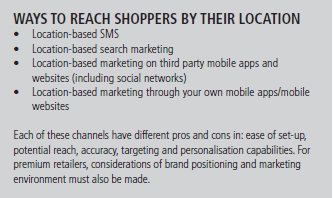



The state of shopper marketing: How to make your POS work harder
share on
Take a look at the beautiful new storefront facades along Orchard Road, and you can easily sense the competitiveness of Singapore’s retail landscape, with every retailer constantly trying to increase their business and stand out from their neighbours.
In many general marketing campaigns, physical retail points are largely passive beneficiaries, a footnote written in small-type at the bottom of branding ads. The customer walking into your store is a result of your successful marketing, advertising and PR campaigns in tried-and-tested media channels. It’s a method that works well in Singapore, but times are changing.
Consumers are diversifying their information consumption patterns, and even their shopping habits because of increased choices available digitally. We have, in particular, the advent of the smartphone, and the mobile apps, services and content within (and our collective addiction to it) to thank for that.
Point of sale (POS) now needs to work harder than ever before to attract shoppers. But new opportunities have also emerged that allow retailers to maximise performance of individual POS’s.
A CHANNEL PERFECT FOR RETAILERS: MOBILE MARKETING
Mobile marketing’s benefit for physical retailers is obvious. Unshackled from a physical print format or desk-bound hardware, it is the most powerful way to reach shoppers while they are shopping. Shoppers, while they are shopping, are least marketed to, and yet, at their most suggestible state – they are already out shopping! If you can send them a targeted and relevant message, you have a high chance of
making sales on the same day.
Here we have some suggestions that will enable retailers to extract maximum value from each POS.
1. Empower your POS to reach out
Location-based mobile marketing, more than any other medium,
empowers retailers to pinpoint the perfect confl uence of right-place, righttime, right-person, right-message. It allows each POS to “reach out” and communicate with the shoppers physically close to it.
The first step in making your POS work harder is to see it as an active marketing asset, and not simply a passive destination for purchases. Indeed, much investment and effort is made by you in designing your
stores, picking the right product mix and displaying it in the most appealing way. For premium retailers, the store is probably the most powerful manifestation of your brand image, much more so, than any single product within it.
In this new age of hyper-local marketing, we can defi ne compelling location-relevant reasons for shoppers near to your POS to visit that particular POS today. Some suggestions:
• Do you have new products in-store today?
• Are you running any special activities in-store today?
• Has your store been recently refurbished?
• Do you have any new displays in-store, packed with great collections?
• Is your store the only one in the area that carries a particular product or collection?
• Do you have any in-store loyalty or rewards programmes?
• If your brands carry multiple product categories, will you be able to put a mix-and-match look together for items found only in your store?
A successful mobile marketing strategy will have to combine the right message with the right channel (see breakout box). Key KPIs from a mobile marketing campaign will have to include walk-in traffic, conversion rate, and, of course, sales generated.
Yet, in determining the right marketing message, we do not recommend that daily price deals form your core mobile strategy. They are great for tactical sales boosts, but they are not engineered to engender
brand loyalty on their own.
2. Empower your POS to be a data-collecting, shopper-engaging machine for your marketing efforts
It is easy to be impressed with the sophistry of e-commerce kingpin Amazon’s recommendations engine. Through collecting, analysing and understanding individual customer preferences, and giving targeted
recommendations, incredible customer loyalty is generated.
A shopper entering your store is similarly in an environment that you fully control, enjoying an experience which you create through your store design, product mix and your personal service.
We have some suggestions that will increase the role and importance of your POS in your entire marketing strategy.
COLLECTING DATA
In most POS, shoppers are asked to join the mailing list only after they have bought something. However, any shopper browsing your products (and perhaps asking questions) in your store has already shown a much higher interest in your products compared with the average shopper on the street.
This is a highly valuable prospect, and you should endeavour to invite them to join your mailing list. Emphasise the exclusive information they will receive as part of the mailing list. Do include as much detail on shopping preferences of the person as possible. Indeed, data collection should be
systemised and incentivised as a core marketing function, and not just left to individual sales staff to implement as a sales function.
This empowers your “reach out” campaigns and is the starting point for understanding the buying process of your customers better. In this increasingly competitive landscape, all contact or behaviour
data on current or prospective customers must be valued, and the POS is
a perfect place to gather it.
ENGAGING THE SHOPPER
Concerns about show rooming are ever-present among retailers. Our suggestion is that since you will never be able to stop it (unless you ban mobile phones in your stores), the best approach is to actively engage the shoppers, and make sure your stores themselves are not passive bystanders to the practice.
Indoor micro-location is an interesting technology that can go far in accomplishing this. Through physical sensors installed in-store, working together with apps in the shopper’s mobile phone, you will be able to detect accurately the physical location of shoppers within your store.
This then empowers you to push specialised information and offers to shoppers, for example, when they are beside or in front of a particular product or counter. If the pushed information or offers are special or
exclusive, you can increase shopper engagement.
There are increasing numbers of start-up companies offering these services, and our prediction is that in particular, micro-location, based on Bluetooth Low Energy beacons, will soon receive mass commercial use (chiefly because of Apple’s support for the technology in iOS 7, its low-cost and its comparatively simple set-up).
Indeed, with the significant developments in mobile technologies relating to micro-location, we recommend retailers take the time to explore options relating to it.
The goal is not to provide an entertaining distraction for the shopper. It is part of letting the customer know that your POS is more than just a remote and cold venue, detached from their mobile habits. It is a gateway gesture encouraging them to provide you with more data about themselves.
3. Integrate your POS into your omni-channel strategy
Many retailers are also launching their own e-commerce or m-commerce platforms. (Club 21 is a great example of a company that has executed a very complete and coherent omni-channel strategy.)
It is here a POS network can provide huge advantages.
An online purchaser can pick up the item in-store, where they can check the item physically before pick-up, redeem loyalty rewards points in-store and, of course, be persuaded to buy Don’t believe the general press when brick-and-mortar retailing. On the contrary, technologies emerging now, means physical to exploit their natural advantages.
The writer is Julian Peh, CEO of WhiteWave Retail Boosters, a consultancy specialising in retail marketing products and services for premium retailers.
ABOUT WHITEWAVE RETAIL BOOSTERS
With a combination of proprietary apps and white-label software solutions, WhiteWave Retail Boosters serves more than 60 premium and luxury retailers in Singapore and Hong Kong. Its proprietary apps Luxury Locator have attracted more than 36,000 downloads from shoppers. WhiteWave Retail Boosters is a subsidiary of WhiteWave Media Group, Asia’s leading integrated luxury media company, with offices in Singapore, Hong Kong and Shanghai. Please visit www.WW-Retail.com for more details.
share on
Free newsletter
Get the daily lowdown on Asia's top marketing stories.
We break down the big and messy topics of the day so you're updated on the most important developments in Asia's marketing development – for free.
subscribe now open in new window

